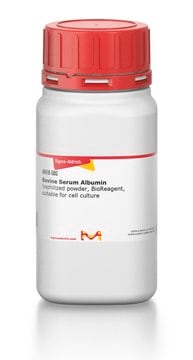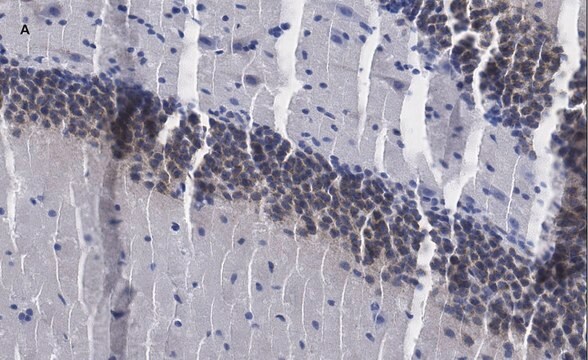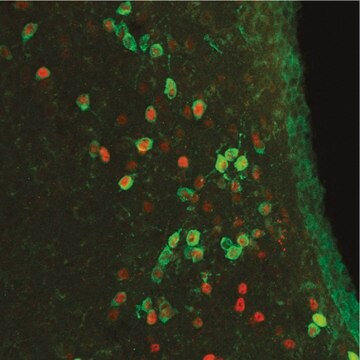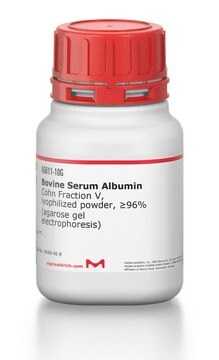推荐产品
一般說明
Immunoaffinity purified rabbit polyclonal antibody. Recognizes the ~50-62 kDa c-Fos protein.
Recognizes the ~50-62 kDa c-Fos protein in HepG2, NIH3T3, and MCF-7 cells.
The proto-oncogene fos has been implicated in cell growth, differentiation and development. fos is induced by a large number of stimuli including mitogens, differentiation-specific agents, pharmacological agents, etc. Induction of the 62,000 dalton fos protein is rapid but transient. The fos protein is associated with a 39,000 dalton protein which has been identified as the protein product of the jun proto-oncogene (c-jun). The fos/jun protein complex binds specifically to a sequence element in DNA referred to as the AP-1 binding site.
This Anti-c-Fos (Ab-2) (4-17) Rabbit pAb is validated for use in Frozen Sections, WB, IF, IP, Paraffin Sections, Gel Shift, for the detection of c-Fos (Ab-2) (4-17).
免疫原
Human
a synthetic peptide (SGFNADYEASSSRC) (Cat. No. PP10) corresponding to amino acids 4-17 of human c-Fos
應用
Frozen Sections (5-10 µg/ml)
Immunoblotting (1-5 µg/ml)
Immunofluorescence (1-5 µg/ml)
Immunoprecipitation (1-2 µg per reaction)
Paraffin Sections (5-10 µg/ml, heat or pepsin pre-treatment required)
Gel Shift (see comments and application references)
Free-floating Sections (not recommended)
Immunoblotting (1-5 µg/ml)
Immunofluorescence (1-5 µg/ml)
Immunoprecipitation (1-2 µg per reaction)
Paraffin Sections (5-10 µg/ml, heat or pepsin pre-treatment required)
Gel Shift (see comments and application references)
Free-floating Sections (not recommended)
警告
Toxicity: Standard Handling (A)
外觀
Lyophilized from PBS, a volatile buffer, 100 µg BSA.
重構
Resuspend the lyophilized antibody with sterile phosphate buffered saline (PBS), pH 7.4, or sterile 20 mM Tris-saline (20 mM Tris containing 0.15 M NaCl), pH 7.4, to yield a final concentration of 100 µg/ml; product will be more stable if 0.1% sodium azide is included (do not add azide if antibody is to be used with viable cells). Lyophilized antibodies should be resuspended at 4°C with occasional gentle mixing.
分析報告
Positive Control
Hep G2 or NIH 3T3 cells
Hep G2 or NIH 3T3 cells
其他說明
DeTogni, P., et al. 1988. Cell Biol.8, 2251.
Rouscher III, F.J., et al. 1988. Science240, 1010.
Sassone-Corsi, P., et al. 1988. Cell54, 553.
Verma, I.M. and Graham, W.R. 1987. Cancer Res.49, 29.
Verma, I.M. and Sassone-Corsi, P. 1987. Cell51, 513.
Muller, R. 1986. Biochim. Biophys. Acta823, 207.
Verma, I. 1986. Trends Genet.2, 93.
Greenberg, M. and Ziff, E. 1984. Nature (London), 311, 433
Rouscher III, F.J., et al. 1988. Science240, 1010.
Sassone-Corsi, P., et al. 1988. Cell54, 553.
Verma, I.M. and Graham, W.R. 1987. Cancer Res.49, 29.
Verma, I.M. and Sassone-Corsi, P. 1987. Cell51, 513.
Muller, R. 1986. Biochim. Biophys. Acta823, 207.
Verma, I. 1986. Trends Genet.2, 93.
Greenberg, M. and Ziff, E. 1984. Nature (London), 311, 433
For gel shift assays resuspend in 100 µl of buffer. The immunogen, c-fos (Peptide-2), Cat. No. PP10, is also available for competition studies (see Murphy, et al. below). Antibodies should be titrated for optimal results in individual systems.
法律資訊
CALBIOCHEM is a registered trademark of Merck KGaA, Darmstadt, Germany
未找到合适的产品?
试试我们的产品选型工具.
儲存類別代碼
10 - Combustible liquids
水污染物質分類(WGK)
nwg
閃點(°F)
Not applicable
閃點(°C)
Not applicable
M E Greenberg et al.
Nature, 311(5985), 433-438 (1984-10-04)
Transcription of the c-fos proto-oncogene is greatly increased within minutes of administering purified growth factors to quiescent 3T3 cells. This stimulation is the most rapid transcriptional response to peptide growth factors yet described, and implies a role for c-fos in
P Sassone-Corsi et al.
Cell, 54(4), 553-560 (1988-08-12)
Proto-oncogene fos encodes a nuclear protein that appears to be involved in the transcriptional regulation of some genes. fos protein (p55fos) is associated with other nuclear proteins in complexes that bind to regulatory regions containing TPA-responsive promoter elements (TREs). The
The fos oncogene.
I M Verma et al.
Advances in cancer research, 49, 29-52 (1987-01-01)
Proto-oncogene fos: complex but versatile regulation.
I M Verma et al.
Cell, 51(4), 513-514 (1987-11-20)
Lisa Y Maeng et al.
Journal of neural engineering, 16(2), 026022-026022 (2019-01-09)
Neurostimulation technologies are important for studying neural circuits and the connections that underlie neurological and psychiatric disorders. However, current methods come with limitations such as the restraint on movement imposed by the wires delivering stimulation. The objective of this study
我们的科学家团队拥有各种研究领域经验,包括生命科学、材料科学、化学合成、色谱、分析及许多其他领域.
联系技术服务部门





